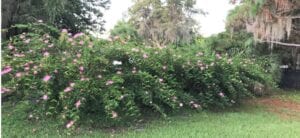I am passionate about our environment and want to help you have a beautifully landscaped yard while being conscious of the world around you.. here are a few good practices to implement in your planning.

Powderpuff Tree
(powderpuff tree.. not a native, (Bolivia) but Florida Friendly.. attracts birds, butterflies & bees)
1. Planting the Right Plant in the Right Place
The main thing in placing plants is to not waste time, money, and energy caring for plants that will not adapt in the spot you plant it. Some plants prefer sun, some shade others are very drought tolerant while some prefer moist soil. You may need to amend your soil by adding some compost unless your planting native plants.
For details on Florida Friendly Plants.. see http://sfyl.ifas.ufl.edu/media/sfylifasufledu/sarasota/documents/pdf/hortres/2015_HortRes_FYN_Plant_Selection_Guide_2015.pdf
2. Water Efficiently
Water is a limited resource and should be used wisely. We often overwater unintentionally. Overwatering does more than deplete water supply, it also makes plants more prone to disease and pests. Therefore, plants are likely to develop fungal problems that require treatment with pesticides.
3. Fertilize Appropriately
All plants need nutrients for growth. They obtain them from soil or other mediums. Supplemental nutrients can be supplied through composted organic material, packaged fertilizer, or specific minerals such as magnesium or iron.
Too much fertilizer can weaken a plant, promote disease, invite pests, and harm our environment. Before you fertilize, one should determine if it’s needed. Some plants are prone to specific kinds of nutrient deficiencies (example.. Ixora & palms tend to run low on potassium and manganese).
Signs…. Iron deficiency appears first in the tips of the leaf blade and nitrogen displays a yellowing of the entire leaf blade. Nutrient deficiencies can look similar so it is important to research before diagnosing. Click for detailed info.. https://gardeningsolutions.ifas.ufl.edu/care/fertilizer/
4. Mulch
Keeps moisture in the soil, helps control weeds, and reduces stormwater runoff. It improves the soil as if breaks down and adds organic matter to the soil.
5. Attract Wildlife
Bring your yard to life by providing water, food, and shelter for birds, butterflies, and other creatures.. Florida is a state renowned for its diverse and unique ecosystem. Rapid development is continuing to destroy wildlife habitat. There is much YOU can do to create a safe haven for the displaced wildlife so that we don’t lose them.
Provide food.. select plants with seeds, fruit, foliage, or flowers that butterflies, birds, and other wildlife like to eat. Supply water.. a pond or a creek is great but a fountain or birdbath will also encourage wildlife. Just make sure to empty and clean your birdbath every few days. Do not use soap or bleach, just scrub all surfaces with a brush or sponge and change the water regularly to prevent mosquitos and bacterial contamination. Click here for more info: https://gardeningsolutions.ifas.ufl.edu/design/gardening-with-wildlife/
6. Manage Yard Pests Responsibly
Create an effective defense against pests while minimizing your impact on the environment. Scientists now recommend using Integrated Pest Management (IPM) a strategy that helps gardeners prevent and manage pest problems with as few chemicals as possible.
- Select plants that are pest resistant.
- Using proper amounts of water and fertilizer is the best defense against pests.
- Keep an eye on your yard’s plants to detect pest problems early before significant damage occurs.
- Learn to recognize the insects in your garden that help manage pests and let them continue their good work.
- Remember, in order to have “good guys, “such as ladybugs, there must be some “bad guys” or pests, for them to feed on.
- Remove affected leaves on plant parts.
- Don’t treat by default. There will always be insects in any healthy landscape, so don’t worry about minor damage.
- Spot-treat only. Never use blanket applications to treat problems.
For more info on about specific yard pests, diagnosing pest problems, and controlling pests visit http://ipm.ifas.ufl.edu
7. Recycle
Reuse your yard waste to save money and enrich your soil. Leave clippings on the lawn after mowing, they’ll decompose, returning nutrients to the turf. Pruning parts of plants to improve plant health, control growth, or enhance fruiting, flowering and appearance. Learn more about proper pruning visit http://gardeningsolutions.ifas.ufl.edu
8. Composting
A common misconception about plant care is that all plants require fertilizer. Plants do need nutrients, but they might not need added fertilizer if you add compost. That is because as organic matter decomposes, nutrients are released into the soil in a form that plants can utilize. Visit http://gardeningsolutions.ifas.ufl.edu for more info on how to compost.
9. Reduce Stormwater Runoff
Filter rain through your landscape to protect waterways and replenish the aquifer. Rain Gardens are an easy and attractive way to reduce the amount of stormwater runoff that leaves your landscape. These shallow areas are planted with grasses and other plants to filter water before letting it flow naturally into the ground. Water kept within a landscape this way returns to the aquifer, helping to replenish Florida’s water supplies. Rain Barrels can capture a significant amount of water and can have a tangible effect on your water bill – especially when two or more rain barrels are connected together. They are fairly easy to find in stores and make at home! For more info.. http://sfyl.ifas.ufl.edu/sarasota/gardening-and-landscaping/horticulture-residential/florida-yards-and-neighborhoods/rain-barrels/
10. Protect the Waterfront
Help preserve Florida’s waterways, plants, and wildlife. Florida is covered with water. The state boasts over 10,000 miles of rivers and streams, about 7800 lakes, more than 700 freshwater springs, and the second-longest coastline in the United States (Alaska is the first). Even if you do not reside on a waterfront, the land you live on is directly connected to a nearby water body. No matter where you live, surface water that leaves your landscape as runoff, together with any fertilizers and pesticides in that runoff, will eventually drain into a water body. For more info read.. https://edis.ifas.ufl.edu/ep374
For more details on these principals see.. https://ffl.ifas.ufl.edu/materials/FYN_Handbook_2015_web.pdf
